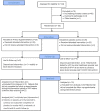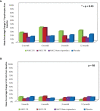AHCC® Supplementation to Support Immune Function to Clear Persistent Human Papillomavirus Infections
- PMID: 35814366
- PMCID: PMC9256908
- DOI: 10.3389/fonc.2022.881902
AHCC® Supplementation to Support Immune Function to Clear Persistent Human Papillomavirus Infections
Abstract
Objective: To determine the efficacy, safety, and durability of the use of AHCC supplementation for 6 months to support the host immune system to clear high-risk human papillomavirus (HPV) infections. The AHCC supplement is a proprietary, standardized extract of cultured lentinula edodes mycelia (AHCC®, Amino Up, Ltd., Sapporo, Japan) that has been shown to have unique immune modulatory benefits.
Study design: This was a randomized, double-blind, placebo-controlled study (CTN: NCT02405533) in 50 women over 30 years of age with confirmed persistent high-risk HPV infections for greater than 2 years. Patients were randomized to placebo once daily for 12 months (N = 25) or AHCC 3-g supplementation by mouth once daily on empty stomach for 6 months followed by 6 months of placebo (N = 25). Every 3 months, patients were evaluated with HPV DNA and HPV RNA testing as well as a blood sample collected to evaluate a panel of immune markers including interferon-alpha, interferon-beta (IFN-β), interferon-gamma (IFN-γ), IgG1, T lymphocytes, and natural killer (NK) cell levels. At the completion of the 12-month study period, patients on the placebo arm were given the option to continue on the study to receive AHCC supplementation unblinded for 6 months with the same follow-up appointments and testing as the intervention arm.
Results: Fifty women with high-risk HPV were enrolled, and 41 completed the study. Fourteen (63.6%) of the 22 patients in the AHCC supplementation arm were HPV RNA/HPV DNA negative after 6 months, with 64.3% (9/14) achieving a durable response defined as being HPV RNA/HPV DNA negative 6 months off supplementation. On the placebo arm, two (10.5%) of 19 patients were HPV negative at 12 months. In the twelve placebo arm patients who elected to continue on the unblinded study, 50% (n = 6) were HPV RNA/HPV DNA negative after 6 months of AHCC supplementation. At the time of completion of the study, there were a total of 34 patients (22 blinded and 12 unblinded) who had received AHCC supplementation with an overall response rate of 58.8% that cleared HPV persistent infections. At the time of enrollment, the mean IFN-β level was 60.5 ± 37.6 pg/ml in women with confirmed persistent HPV infections. Suppression of IFN-β to less than 20 pg/ml correlated with an increase in T lymphocytes and IFN-γ and durable clearance of HPV infections in women who received AHCC supplementation.
Conclusion: Results from this phase II study demonstrated that AHCC 3 g once daily was effective to support the host immune system to eliminate persistent HPV infections and was well tolerated with no significant adverse side effects reported. The duration of AHCC supplementation required beyond the first negative result needs more evaluation to optimize success for durable outcomes. The suppression of the IFN-β level to less than 20 pg/ml correlated with clearance of HPV infections and merits further evaluation as a clinical tool for monitoring patients with HPV infections.
Clinical trial registration: clinicaltrials.gov/ct2/, identifier NCT02405533.
Keywords: AHCC; HPV; cancer prevention; cervical cancer; immunomodulation; interferon-beta; nutritional supplements.
Copyright © 2022 Smith, Gaikwad, Mathew, Rech, Faro, Lucci, Bai, Olsen and Byrd.
Conflict of interest statement
JS was a recipient of various unrestricted research grants supporting preclinical studies on AHCC prior to 2014 from Amino Up, Ltd. The remaining authors declare that the research was conducted in the absence of any commercial or financial relationships that could be construed as a potential conflict of interest.
Figures




Similar articles
-
From Bench to Bedside: Evaluation of AHCC Supplementation to Modulate the Host Immunity to Clear High-Risk Human Papillomavirus Infections.Front Oncol. 2019 Mar 20;9:173. doi: 10.3389/fonc.2019.00173. eCollection 2019. Front Oncol. 2019. PMID: 30949451 Free PMC article.
-
Safety and Efficacy of Imatinib for Hospitalized Adults with COVID-19: A structured summary of a study protocol for a randomised controlled trial.Trials. 2020 Oct 28;21(1):897. doi: 10.1186/s13063-020-04819-9. Trials. 2020. PMID: 33115543 Free PMC article.
-
Modulation of T Regulatory and Dendritic Cell Phenotypes Following Ingestion of Bifidobacterium longum, AHCC® and Azithromycin in Healthy Individuals.Nutrients. 2019 Oct 15;11(10):2470. doi: 10.3390/nu11102470. Nutrients. 2019. PMID: 31618905 Free PMC article. Clinical Trial.
-
The Effects of AHCC®, a Standardized Extract of Cultured Lentinura edodes Mycelia, on Natural Killer and T Cells in Health and Disease: Reviews on Human and Animal Studies.J Immunol Res. 2019 Dec 20;2019:3758576. doi: 10.1155/2019/3758576. eCollection 2019. J Immunol Res. 2019. PMID: 31930148 Free PMC article. Review.
-
Mitoxantrone: a review of its use in multiple sclerosis.CNS Drugs. 2004;18(6):379-96. doi: 10.2165/00023210-200418060-00010. CNS Drugs. 2004. PMID: 15089110 Review.
Cited by
-
The Inhibitory Effect of KerraTM, KSTM, and MinozaTM on Human Papillomavirus Infection and Cervical Cancer.Medicina (Kaunas). 2023 Dec 14;59(12):2169. doi: 10.3390/medicina59122169. Medicina (Kaunas). 2023. PMID: 38138272 Free PMC article.
-
AHCC inhibited hepatic stellate cells activation by regulation of cytoglobin induction via TLR2-SAPK/JNK pathway and collagen production via TLR4-NF-κβ pathway.Am J Physiol Gastrointest Liver Physiol. 2024 Dec 1;327(6):G741-G753. doi: 10.1152/ajpgi.00134.2024. Epub 2024 Sep 24. Am J Physiol Gastrointest Liver Physiol. 2024. PMID: 39316687 Free PMC article.
-
Medicinal Mushrooms, Probiotics and Combination of Natural Compounds in the Management of HPV: A Comparative Look at Viral Clearance and Lesion Resolution.Viruses. 2025 Jul 2;17(7):942. doi: 10.3390/v17070942. Viruses. 2025. PMID: 40733559 Free PMC article. Review.
-
Mushrooms as future generation healthy foods.Front Nutr. 2022 Dec 6;9:1050099. doi: 10.3389/fnut.2022.1050099. eCollection 2022. Front Nutr. 2022. PMID: 36562045 Free PMC article. Review.
-
Human papillomavirus and cervical cancer in the microbial world: exploring the vaginal microecology.Front Cell Infect Microbiol. 2024 Jan 25;14:1325500. doi: 10.3389/fcimb.2024.1325500. eCollection 2024. Front Cell Infect Microbiol. 2024. PMID: 38333037 Free PMC article. Review.
References
-
- Furumoto H, Irahara M. Human Papillomavirus (HPV) and Cervical Cancer. The Journal of Medical Investigation: JMI. (2002) 49(3-4):124–33. - PubMed
-
- About HPV, Centers for Disease Control and Prevention. Available at: https://www.cdc.gov/hpv/parents/about-hpv.html?CDC_AA_refVal=https%3A%2F... Accessed 9/13/19.
-
- Sexually Transmitted Diseases (STDs). Centers for Disease Control and Prevention. Available at: https://www.cdc.gov/std/hpv/default.htm accessed 9/17/19.
Associated data
LinkOut - more resources
Full Text Sources
Medical

